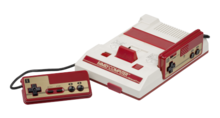
Back NES AN نينتندو إنترتينمنت سيستم Arabic نينتيندو انترتينيمنت سيستم ARZ Nintendo Entertainment System AST Nintendo Entertainment System Byelorussian Nintendo Entertainment System Breton Nintendo Entertainment System BS Nintendo Entertainment System Catalan سیستمی چێژبەخشی نینتێندۆ CKB Nintendo Entertainment System Czech
 | |
Top: NES Control Deck (with detachable controllers) Bottom: Family Computer ("Famicom") main unit (with hardwired controllers) | |
| Also known as | Family Computer/Famicom (Japan) Hyundai Comboy (South Korea) Samurai Electronic TV Game System (India) Dendy (Post-Soviet countries) Nintendo Entertainment System (PAL A/PAL B/Southeast Asia) |
|---|---|
| Developer | Nintendo R&D2 |
| Manufacturer | Nintendo |
| Type | Home video game console |
| Generation | Third |
| Release date | |
| Lifespan | 20 years |
| Introductory price | ¥14,800 (equivalent to ¥18,365 in 2019) US$179 (equivalent to $510 in 2023)[5] |
| Discontinued | |
| Units sold | 61.91 million[7] |
| Media | Nintendo Entertainment System Game Pak |
| CPU |
|
| Display | 256 × 240 px |
| Graphics | PPU (Ricoh 2C02) |
| Sound | APU, 5 channels: 2 pulse wave, triangle wave, white noise, DPCM |
| Controller input | 2 controller ports[c] 1 expansion slot |
| Best-selling game |
|
| Predecessor | Color TV-Game |
| Successor | Super NES |
| Related | Famicom Disk System, Famicom 3D System |
The Nintendo Entertainment System (NES) is an 8-bit third-generation home video game console produced by Nintendo. It was first released in Japan in 1983 as the Family Computer (FC),[note 1] commonly referred to as Famicom.[note 2] It was redesigned to become the NES, which was released in American test markets on October 18, 1985, and was soon fully launched in North America and other regions.
After developing several successful arcade games in the early 1980s such as Donkey Kong (1981), Nintendo planned to create a home video game console. Rejecting more complex proposals, the Nintendo president Hiroshi Yamauchi called for a simple, cheap console with games stored on cartridges. The controller design was reused from Nintendo's portable Game & Watch games. Nintendo released several add-ons, such as the NES Zapper light gun for shooting games like Duck Hunt.
The NES is one of the best-selling consoles of its time and helped revitalize the US gaming industry following the video game crash of 1983.[10][d] It pioneered a now-standard business model of licensing third-party developers to produce and distribute games.[12] The NES features several groundbreaking games, such as the 1985 platform game Super Mario Bros. and the 1986 action-adventure games The Legend of Zelda and Metroid, which became long-running franchises. It was succeeded in 1990 by the Super Nintendo Entertainment System. In 2011, IGN named the NES the greatest video game console of all time.[13]
- ^ Kohler, Chris (October 18, 2010). "Oct. 18, 1985: Nintendo Entertainment System Launches". WIRED. Archived from the original on November 26, 2020. Retrieved June 11, 2015.
- ^ "Nintendo Wii and DS to launch in India". Archived from the original on September 29, 2022. Retrieved September 25, 2022.
- ^ https://www.youtube.com/watch?v=MwPXJOs0ixg Archived June 26, 2023, at the Wayback Machine 7:48
- ^ "Video Games Around the World: South Africa". Archived from the original on September 25, 2022. Retrieved September 25, 2022.
- ^ Levin, Martin (November 20, 1985). "New components add some Zap to video games". San Bernardino County Sun. p. A-4.
- ^ "Nintendo Entertainment System (NES) – 1985–1995". Classic Gaming. GameSpy. Archived from the original on October 29, 2012. Retrieved December 20, 2019.
- ^ a b "Consolidated Sales Transition by Region" (PDF). Nintendo. March 2016. Archived (PDF) from the original on April 27, 2016. Retrieved September 12, 2022.
- ^ Stuart, Keith (September 13, 2010). "Super Mario Bros: 25 Mario facts for the 25th anniversary". The Guardian. Archived from the original on August 9, 2017. Retrieved November 2, 2018.
- ^ Goss, Patrick. "The games that sold consoles". MSN. Archived from the original on March 9, 2008. Retrieved September 24, 2011.
- ^ Consalvo, Mia (2006). "Console video games and global corporations: Creating a hybrid culture". New Media & Society. 8 (1): 117–137. doi:10.1177/1461444806059921. S2CID 32331292.(Subscription required.)
- ^ a b Cite error: The named reference
Game Overwas invoked but never defined (see the help page). - ^ Sanchez-Crespo, Daniel (September 8, 2003). Core Techniques and Algorithms in Game Programming. New Riders Games. p. 14. ISBN 0-13-102009-9.
- ^ "Nintendo Entertainment System (NES) is number 1 – IGN". IGN. 2011. Archived from the original on July 10, 2022. Retrieved July 10, 2022.
Cite error: There are <ref group=lower-alpha> tags or {{efn}} templates on this page, but the references will not show without a {{reflist|group=lower-alpha}} template or {{notelist}} template (see the help page).
Cite error: There are <ref group=note> tags on this page, but the references will not show without a {{reflist|group=note}} template (see the help page).
© MMXXIII Rich X Search. We shall prevail. All rights reserved. Rich X Search

